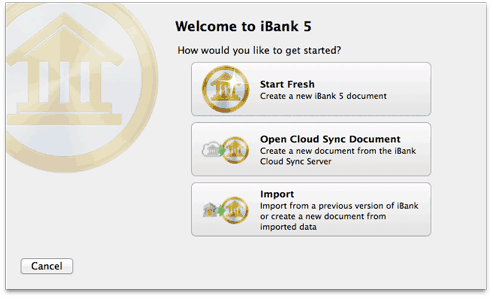Once you have chosen which accounts to include, click 'Next' twice to continue. IBank will prompt you to enter a name for the QIF file and choose the location where it should be saved. Click 'Save' to complete the export process. Open the iBank document you want to export and choose File Export. Using the drop-down menu button. Convert from Quicken for Mac to Quicken for Windows Important: The option to convert data from Quicken for Mac to Quicken for Windows is available, but completing this conversion with a file that contains investment accounts may result in investment data loss. A MAC.qbb file is a copy of a QuickBooks Desktop company file that you can restore in QuickBooks for Mac. Here’s how: Update QuickBooks Desktop for Mac to the latest release. Close QuickBooks. Copy the backup to the Documents folder on your Mac. Reopen QuickBooks Desktop for Mac, then select File, then select Open Company. OFX format is supported by many applications such Microsoft Money, Sage, Sage 50, Sage One, XERO, PeachTree, Simply Accounting, Quickbooks online, YNAB, Wave Accounting, LessAccounting, Quicken. One last thing: Speaking of other operating systems, there are Quicken and iBank apps for iOS. I haven't tried the Quicken app for iOS, but iBank has excellent iPhone and iPad apps that sync.
I switched to a Mac in early 2005 and although I don’t see myself ever willingly going back to Windows at home (I use it at work), the one area that makes me wish I was on a PC is personal finance software. I’ve been a Quicken user since 2000 and have enjoyed the benefits of easily tracking my spending, budgeting, online bill pay and cash flow forecasting for almost all of my adult life. I can still remember pondering the switch to Mac and thinking, “oh great, they have Quicken for Mac.” But that was the last time I thought of a product from Intuit in a positive light. Converting from Quicken for PC to Mac was one of the most difficult software migrations I’ve ever done — and I do them for a living. I spent countless hours on the phone with support trying to figure out why my registrars didn’t balance when I imported my qif files — no, Intuit doesn’t support a direct import, but rather you export everything and import it back in. In the end I made the transition and missed the superior PC version of Quicken, holding my breath as Intuit released paid upgrades to its Mac product, only to realize none of my beefs were addressed.

But hey, at least it worked and it had many of the same features I had in the PC world, that was until Lion came along. Faced with the choice to upgrade to Quicken Essentials or to not upgrade to Lion, I bit the bullet and hoped for the best. That hope was unfounded as I lost access to one of my favorite features, online bill pay. For the past 10 years I’ve entered a transaction into Quicken and had it paid by my bank automatically, but not anymore. Now I have to enter the transaction into my bank’s website and then enter it again into Quicken — if I wait for the transaction to clear, which will enter it automatically, I don’t have the ability to forecast my cash flow. That is bad enough, but the budget tool in Quicken Essentials does not work, I won’t go over the details here, but the issues are well documented in the Intuit community forums.

Convert From Ibank To Quicken For Mac Windows 10

Ibank Software
And so last month I decided to get serious about budgeting and while a spreadsheet does a pretty decent job at a high level, tracking my day-to-day spending against the budget on a spreadsheet is anything but workable. At first I tried HomeBudget for the iPhone and while it was ok, I found it tedious to enter each transaction manually since it doesn’t link to my bank account. Then there was the Mint upgrade this month, which added budget features, so I figured now was a time to try it again. Mint is actually pretty good at keeping tracking of spending with a great iPhone app and website. I can quickly open it on the go and categorize my spending and see how I’m doing vs my goals in that category. I haven’t tried it a whole month yet, but I’m hopeful it’ll fit this specific need. The problem is, it only fits this one need, and not all my needs as it doesn’t do cash flow forecasting, at all, or bill pay. I can’t even work on a budget until the month begins — typically I like to get it worked out at least a few days in advanced.
So here I am over two years after Quicken Essentials was released realizing that Intuit is never going to fix it, never going to add online bill pay and never going to add an iPhone app that syncs automatically. So instead I’m using four applications to do what I used to do with a single app (bank site for bill pay, Quicken Essentials for cash flow forecasting and reconciliation, Mint to track day-to-day spending, and Google Docs for my monthly budget).
